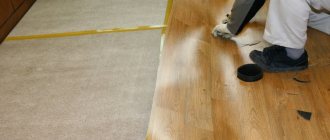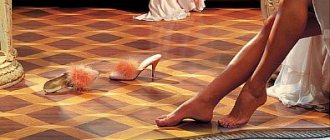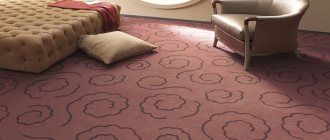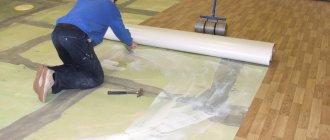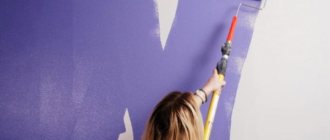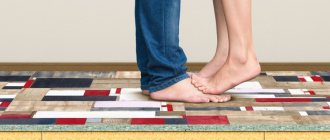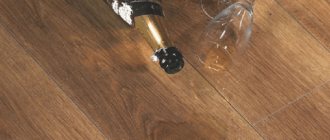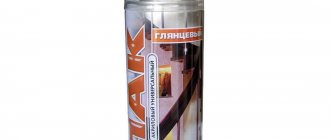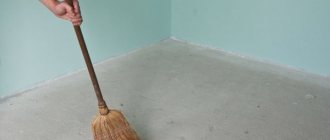About 30–40 years ago, linoleum was the most popular material among numerous domestic developers. There was only one reason, but a very important one - the lowest cost among all flooring materials. Unfortunately, the quality of the old linoleum did not satisfy even very modest requirements, but this factor did not particularly deter consumers.
Is it possible to lay linoleum on old linoleum?
Linoleum was once the most popular flooring
Features of choosing a new floor covering
Over time, linoleum, due to natural physical aging and mechanical damage, becomes unusable and requires replacement. The choice of method for installing a new coating depends on several factors.
Of all floor coverings, linoleum is the most popular
Condition of old linoleum
Over time, any floor covering becomes damaged, but linoleum has its own aging characteristics.
- The pattern on the coating wears out only in certain places, all other areas are in good condition. Such situations often occur in kitchens. The wear and tear is greatest around the kitchen stove, where people walk a lot and constantly wash the floor. If you use cheap detergents that contain acids, the external decorative pattern wears off quite quickly, and then the base is damaged.
If the old linoleum is uneven or has defects, then it is better to dismantle it
- Through cracks appear on the base, part of the linoleum may come off. Very complex damage causes great difficulties when laying a new coating without dismantling the old one. Professional builders do not recommend laying linoleum over old linoleum in such cases; you must first do the preparatory work. Which ones exactly – we will tell you in this article a little lower.
Torn linoleum
- Damage to the coating occurs due to serious problems with the base . The cement screed is uneven, has significant and sharp differences in height, wide cracks, etc. This is the most difficult situation and requires a large amount of construction work.
Changes in the purpose of the room
Sometimes there are cases when it is necessary to change the assignments of rooms. For example, urgently preparing a nursery in connection with the birth of a child or adapting a separate room for elderly parents. And in the old rooms there was linoleum on the floor, it has already lost its original properties, the covering can be changed completely or covered with new linoleum on top. The decision is made taking into account many factors, including the financial capabilities of the apartment owners.
Thanks to the technology of laying new linoleum on the old one, you can reduce labor costs
Carrying out major repairs
Major renovation of interior premises is complex and large-scale construction work. The list includes replacing the finishing of walls and ceilings; this always has a very negative impact on the condition of the floor coverings. Attempts to protect floors by covering them with films or paper do not always help; the surfaces, if not mechanically damaged, are heavily contaminated with construction waste.
Major renovation of the apartment
The fastest and most economical restoration of floor coverings is to cover them with new linoleum, including over the existing one. If the surface of the old floor is within normal limits, then there is no need to do any preparatory measures; laying linoleum is much simpler.
Emergency situations
This means burst heating or water supply pipes, minor fires and other unpleasant situations. None of the owners of houses and apartments prepares for force majeure situations; they always arise unexpectedly. Eliminating them requires a lot of financial resources, and not everyone has them. Covering the floors with linoleum is the most budget-friendly solution . It can be permanent or temporary, it all depends on financial capabilities, the quality of the new linoleum and the personal preferences of the home owners.
Is it possible to lay new linoleum on old
For reference
When deciding to use adhesive, you need to consider the prospects for when you have to replace the floor covering again. In this case, you will spend a lot of money to dismantle the glued pie. If you still don’t want to remove the old layer, then you can do without glue, and on an area of 20 m2 this solution will be the most suitable. For larger areas, you can use pressure skirting boards. Using objects you can fix the rolled material.
Under what conditions can you lay new linoleum on old
The final answer depends on the actual condition of the flooring, how it was installed and the characteristics of the subfloor. Although experienced builders do not recommend laying new coatings over old ones, some developers disagree with them and make their own decisions. This is done for several reasons. Some are too lazy to dismantle leaky linoleum, while others think that in this way it will be possible to increase the service life and improve performance characteristics. Still others want to renovate the room as quickly as possible and without any construction debris.
Using old linoleum as a base, you can save about 650 rubles. per 1 m²
You need to know that it is possible to lay new material on the old one only in cases where the following conditions are met.
- The surface of the old linoleum does not have through gaps. The coating laying technology prohibits fluctuations in the height of the base by more than 1 mm per linear meter. Linoleum is a soft coating that replicates the surface and hardly hides unevenness. If there are such differences in height, then unevenness will certainly appear on the new surface, and this not only worsens the appearance. The fact is that along sharp bend lines wear becomes noticeable very quickly - the decorative pattern wears out, and the likelihood of the formation of through abrasions increases significantly. The explanation is simple. In these places, the loads are point or linear in nature, which greatly increases their value per unit area.
The surface of the old linoleum must meet all requirements
- Old linoleum does not bulge . Over time, after prolonged use, swelling sometimes appears on old linoleum for various reasons. Their sizes can be so large that the new coating is not able to correct problem areas; swelling eventually appears on the new linoleum. Before laying, you need to level the bottom layer of linoleum, and this is not easy to do. Sometimes you have to almost completely tear off the old coating; this is the only way to eliminate swelling.
- The base is level. This refers to a concrete slab or cement-sand screed. As mentioned above, there are strict standards for screed unevenness, which should always be strictly observed. Uneven floors will quickly damage not only the old, but also the new linoleum.
Checking the quality of the floor screed
- The wooden elements of the base are not damaged by fungal diseases or mold . There are options when linoleum is laid on OSB boards or plywood. Before laying new material, you should partially remove the old one and carefully check the condition of the wooden structures. If the slightest problems are identified, it is necessary to completely dismantle the old coating and carefully check the technical parameters of OSB boards or plywood. Depending on their condition, a decision is made on repair, drying and re-impregnation with antiseptics, or a complete replacement.
But in any case, it should be borne in mind that under the old coating, over time, not only dust accumulates, but also various microorganisms: bacteria and mites. They can cause allergic reactions or more severe negative consequences.
Table. Main types of linoleum.
| View, photo | Description |
| Alkyd | It is considered the most environmentally friendly type of linoleum. It consists of fillers, pigments and alkyd resins, due to which the finished material has good sound and heat insulation properties. The buyer also has a wide choice of colors and patterns, which allows them to complement any design. Against the background of all the advantages of alkyd linoleum, it is worth highlighting its disadvantages - or rather, a disadvantage, because there is only one. This is weak resistance to temperature fluctuations. |
| Nitrocellulose | In the manufacture of this type, various dyes, stabilizers, as well as colloxylin are used. Among all the advantages of nitrocellulose linoleum, it is worth highlighting its high water resistance and elasticity. The disadvantages of the material include a high fire hazard. Since linoleum is considered unstable to alkali and acids, it is laid mainly in apartments where people do not use strong chemicals. High-quality and reliable installation requires a properly prepared base. |
| Relin | Two- or three-layer linoleum, in the manufacture of which synthetic rubber is used. Due to its properties, Relin is used in rooms with high humidity. The material is durable, strong, wear-resistant and elastic. |
| PVC linoleum | Based on the name, it is not difficult to guess that PVC with different fillers is used for manufacturing. The advantages of this type include moisture resistance, antistatic, ease of installation and a large selection of colors. But, despite the large number of advantages, PVC linoleum is unable to withstand the effects of alkali, solvents, fats and low temperatures. In a hardware store you can find linoleum both without a base and with different bases, for example, with a foam, non-fabric or fabric base. |
| Rubber | A two-layer type of linoleum, one of the layers (lower) consists of crushed rubber, and the second (upper) is made of synthetic rubber. The material is highly elastic and water resistant. Thanks to the inexpensive components used in the manufacture of linoleum, it acts as a budget option on the market. |
| Colloxylin | Another type of linoleum, which is used for different types of premises. The material itself is quite thin, but this does not affect its quality in any way. Colloxylin linoleum is elastic and moisture resistant. Among the disadvantages is increased flammability. |
Prices for Tarkett linoleum
linoleum tarkett
If possible, it is better to purchase commercial linoleum, as it is of the highest quality.
Important points and recommendations
Laying linoleum requires a responsible and attentive approach, and no less important - good knowledge. After all, not only the appearance of the coating, but also its service life depends on the quality of work.
The first and important tip concerns the use of cold welding. It should be used only if the premises will not require any repairs for a long time. This is due to the fact that when materials are cold welded, dismantling the floor covering will be very complicated. As a rule, special equipment is used to remove multi-layer linoleum, which costs a lot of money. Therefore, before deciding to use cold glue, you need to additionally make sure that you will not have to repair the floor for many years.
The second tip flows smoothly from the first. Many people do not want to prepare the base of the floor in advance, so they simply use ordinary baseboards to secure the linoleum. However, this solution leads to the risk of swelling and unevenness of the coating. Fixing this problem will be quite difficult. In addition, if the interior of the house includes bulky and heavy furniture, in 40% of cases this ends in torn coverings.
The third tip concerns the gluing itself. It is important to know that a poor-quality connection of the material may not be immediately noticeable, but it will manifest itself at the first opportunity. Specifically, with high humidity or strong temperature changes. Under such conditions, the product simply contracts or is stretched. To avoid this, it is necessary to carefully and evenly glue the joints and edges of the joint elements.
General tips for laying new linoleum on old
If the linoleum is not glued, then it is quite easy to remove it. But dismantling is recommended only when there is critical damage to the surface, which will certainly appear on the new coating over time. The second reason for removing the old one is noticeable unevenness in the base. They are easy to detect without dismantling the old linoleum; over time, all problem areas on its surface will be clearly visible.
Old linoleum needs to be removed
Glued linoleum should only be torn off if the old coating is going to be thrown away. The fact is that even theoretically it is impossible to maintain the integrity of the old coating. The use of special construction hair dryers will not help either; when heated, linoleum loses its physical strength much faster than glue that has long hardened. The applied tearing forces cause great damage.
Dismantling old linoleum
What should be an approximate algorithm of actions for those who still decide to lay new linoleum on the old one?
- Carefully inspect the surface, make an audit of its actual standing . If the material has retained its integrity, and only the drawings on the surface have become unusable, then there are no obstacles to continuing the repair work.
- Find out the reason for the appearance of damage on old linoleum. Tears can appear due to the natural physical aging of polymers; they lose their plasticity and crack. Such damage is not considered critical and does not prevent the laying of new linoleum on the old one. In cases where the damage is caused by unevenness of the base, concrete slabs, cement-sand screed or OSB slabs must be repaired before laying. It is impossible to do this without completely dismantling the old coating. The decision to reuse it should be made by the craftsman on site, taking into account the actual condition of the linoleum. The fact is that quite often dismantling causes critical damage to the coating, which makes it impossible to reuse it.
How to eliminate bubbles on linoleum
- Solve the problem with furniture . As the new coating is laid, it can be moved from place to place, raised a little or not touched at all. The first option is considered the most optimal, as it will cover the entire area of the room. But rearranging furniture requires a lot of effort and time; not every apartment owner wants to do such work. As for the second and third options, it is much easier to do this, but it is extremely undesirable. The fact is that situations often arise when, over time, it is necessary to completely replace the furniture. And then big problems arise, because there is no new coating underneath. Another case - the apartment is for sale. If the buyer sees that not the entire area of the room has a new coating, then the price will decrease significantly.
- Remove skirting boards . You need to be prepared for the fact that some of the baseboards will be damaged. In this regard, professional builders recommend immediately purchasing a set of new ones, otherwise you will have to stop work later. An increase in repair time always causes unpleasant situations. It is necessary to anticipate all possible problems and take timely measures to prevent them.
If, after a careful analysis of all the initial data, a decision was made to lay new linoleum over the old one, then the existing requirements of building codes and regulations should be met.
Before installing a new coating, you must stock up on all the necessary tools.
If installed relatively recently
The picture is completely different in the case of a relatively new topcoat with a well-leveled base - there is no such need, it does not need to be removed. Moreover, you can significantly save labor and time on preparation for installation, and since the new flooring may not have a dense base, so will your finances.
The old coating must first be inspected for defects and repaired if necessary. For example, to repair a crack,
you can cut it from both ends in the transverse direction like the letter “H”;- the edges must be bent;
- apply special mastic to the substrate and base;
- Press the material tightly to the floor, it is advisable to place a weight on this place until the glue sets well.
As for the holes found, the easiest way to patch them is if you still have unused pieces from the old coating. You can also ask for unwanted scraps at the store. To ensure a smooth surface after repair, the patch must have a similar backing of the same density.
How to properly design joints?
Cold welding for linoleum (special glue)
Step 1. Spread two pieces of linoleum with an overlap of 3–5 cm. Make sure that the material lies flat without tension or folds.
Pieces of linoleum are laid with overlap
Step 2. Place a metal ruler in the middle of the overlap and carefully cut through the material with a sharp knife. You should cut two layers at once; to do this, the tip must be pressed quite firmly. Keep in mind that you can only cut with a working tool, otherwise the edges will not be smooth, and it is almost impossible to correct the defect.
Cutting linoleum
Step 3. Remove the top and bottom sections. Place a strip of double-sided tape on the old linoleum; it should secure the two edges of the new one. The gluing technology is the same as that usually used during the installation of soft floor coverings.
Removing sections of linoleum
Gluing double-sided tape
Step 4. Place the linoleum in place and press firmly. Place masking tape on top of the cut line. Make sure that all air pockets are removed and the tape fits snugly around the edges. It is recommended to press it down with a special roller, otherwise the glue will get onto the front surface of the linoleum and leave marks on it. It is sometimes impossible to remove such stripes; it all depends on the chemical composition of the active substance and the technical characteristics of linoleum.
Masking tape is rolled with a roller
Step 5. Using the sharp end of a knife, carefully cut the masking tape along the line where the two pieces of coating meet. Work slowly, maintain the cutting direction, and do not go beyond the abutment lines.
Masking tape is cut along the joint line
Step 6. Place the tip on the tube, first make a hole in the sealed stopper. Insert the thin tip into the gap between the pieces of linoleum. Smoothly and evenly move the glue along the joint line, gradually squeeze out the liquid. Make sure that there are no gaps and that the glue does not get beyond the masking tape. The composition must penetrate the entire thickness of the material.
Squeezing out glue
Depending on the drying time recommended by the manufacturer, a strip of tape is removed; in most cases, 8–10 minutes is enough. The linoleum is completely welded on the second day; only after this time has passed, you can walk or install furniture at the joint.
Masking tape is removed
The seam is almost invisible
We described the simplest, so-called cold seam sealing technology. There is also a hot one, but to use it you need to have special expensive tools. In addition, it is not applicable to all types of linoleum, but cold is considered universal.
Types of welding
At the last stage, the baseboards are screwed on. You can use cheap plastic or expensive natural wooden ones. If the design of the skirting boards allows, then it is recommended to simultaneously fix linoleum to the floor; this will greatly increase the strength of the installation of the coating.
Installation of skirting boards
Work methodology
Reaction adhesive will help you install commercial or residential linoleum by gluing it together at the joints. However, the material must be cut taking into account the alignment of the pattern. As a result, you will be able to obtain an almost imperceptible transparent seam, which will only be detectable by touch.
The composition is applied along the edge with a deviation from it. Afterwards the canvases are laid, rolled with a roller, and then you can begin installing the second half of the canvas. If you are thinking about what you can use to glue linoleum, then an alternative solution is to use a two-component polyurethane composition, with which you can obtain a rigid and durable bond. Sometimes a water-dispersed composition is used, which is odorless and environmentally friendly.
Advantages of laying new linoleum over old
There are such advantages, although they are very conditional.
- The performance characteristics of floor coverings are improved . The values of thermal conductivity, tightness and noise absorption almost double. Specific values depend on the condition of the coating and the technical parameters of the new one.
- The volume of work is reduced and the speed of work is increased . There are several reasons - the base is not leveled, there is no need to buy or make cement-sand mortar yourself.
- Much less construction waste . In some cities there are big problems with its disposal. It is prohibited to throw old linoleum into an ordinary trash bin, and it is not always possible to take it to specialized landfills.
One of the main advantages of laying new linoleum on old is saving time during installation
The decision on the method of laying new linoleum should be made slowly, carefully analyzing all the advantages and disadvantages of the various methods.
Video - Tips for laying linoleum
Video - Is it possible to put new linoleum on top of the old one?
Preparing the base
When laying the finishing layer on an existing one, you must:
- Thoroughly sweep and vacuum the base to remove all grains of sand, crumbs and various contaminants.
- Degrease the surface and wait until it dries completely.
- Roll out the piece over the surface, if necessary, trim it along the perimeter of the walls, cut holes for risers and various decorative elements.
- Wait at least a day for the linoleum to take the desired shape.
- Carefully smooth out all the waves that appear on the surface, if necessary, trim the excess again. It is advisable that the sheet should not reach the walls by 20 mm along the entire perimeter (then it will not deform during thermal expansion).
Be sure to glue the new linoleum with mastic or double-sided tape
Gluing is carried out using double-sided tape (a mesh with cells of 30-50 cm is created from it) or special glue (mastic). It is most practical to lay a single sheet in the room so that there are no seams on it.
If this cannot be done, then place the seam perpendicular to the window. The two pieces are connected to each other using cold welding or special glue. Laying sheets without glue is strictly not recommended, since the linoleum may swell.
